AFLW – Round 5 – Collingwood V Melbourne –
Liam Chambers
After last week’s disappointing loss to the Bulldogs, the Dees needed to seize the momentum early. Unfortunately it was the Pies who struck first when Chloe Molloy was awarded a set shot for an infringement.
Then there was more concern when Sinead Goldrick looked to have re injured her knee. Luckily, there seems to have been minimal damage caused. After spending the first five minutes in their defensive 50, the Dees made some headway up the field. Collingwood’s defence was too good though and Melbourne found themselves backtracking without gaining any advantage.
In each of the first three Rounds, Melbourne was dominant in the opening quarters. Even against the Dogs, we controlled the play in our half. However Collingwood took command from the start, marking and kicking well, putting Melbourne on the defensive. Whenever the Dees got too close to scoring, the Pies calmly passed and kicked their way out of trouble.
Finally, Melbourne had a chance when Maddie Gay was taken high. Her set shot went wide for a point. In the last few minutes, the Dees maintained possession but seemed plagued by indecision. When the siren sounded, we could consider ourselves lucky to be only trailing by one goal.
With Collingwood ahead in most of the first quarter statistics, Melbourne needed to knuckle down in order to reverse the trend. However it was the Pies who continued to call the shots and they were unlucky when they hit the post for a second time in the match. Melbourne were at sixes and sevens trying to fend off the attack. Even the ever reliable Daisy Pearce managed to turn the ball over when clearing from the goal square. Aishling Sheridan didn’t hesitate when gifted the chance, kicking the sherrin straight through the uprights.
With the Pies back up at their goal end after the bounce, Melbourne’s defence, normally so consistently steady, was making rookie mistakes. Then the Dees made a dash towards their own goal with Tyla Hanks marking the ball on the run. Her measured tap towards Shelley Scott was forwarded to Kate Hore who failed to take it cleanly. Her subsequent attempt to scoop up the loose ball and burst through was slammed down.
Collingwood continued upping the pressure but then the Dees had a break through on the back of some clever play. First Kate Hore marked from about thirty five metres out but decided to kick to Scott. Shelley took her set shot from a similar distance but missed to the right. Melbourne’s lack of efficiency over the last couple of games has been a bonus for their opponents. A few choice scoring opportunities went begging for the Dees in the second quarter.
Having weathered the Melbourne storm, the Pies went back on the offensive in a major attack. First Chloe Molloy kicked her second on the run before Mikala Cann grabbed the bouncing ball from a throw in and had an easy path to kick Collingwood’s fourth six pointer. While the Pies were on top form in the first half, they also made the Dees looked pedestrian. Melbourne needed to come out fighting if they wanted to get back into the game.
It was a better start for the Dees but both early shots on goal from Tyla Hanks and Sinead Goldrick sailed wide. After dominating for the first five minutes, Melbourne allowed Collingwood to break through and almost conceded another goal. Luckily Aishling Sheridan’s shot hit the post. If all three of the Pies’ strikes on the upright had gone through, the Dees would have been done and dusted by now.
Melbourne again made inroads towards their goal but were again hampered by indecision. The Dees remained goalless; a situation that didn’t alter when Mattie Gay was awarded free kick for a brilliant tackle inside 50. Alas her set shot went wide and the frustration continued in a quarter dominated by Melbourne’s possession of the footy. When Kate Hore marked and kicked to Lily Mithen who in turn kicked the ball back to Hore, it seems like a sensible decision as it placed Kate Hore in a better position in front of goal. Again though it drifted behind for a minor score.
Even when they were dominating, Melbourne seemed directionless. Their set shots kept veering either side of the target. Finally Lauren Pearce saved Demon blushes when she first marked superbly, then ran through a clear path to launch the ball towards goal.
Trailing by sixteen points Melbourne needed to re-enact the third quarter only with more accurate kicking. Regrettably it was the Pies who came out swinging and the Dees again struggled to contain them. When Chloe Molloy marked directly in front of goal and score her third, it looked too high a mountain for Melbourne to climb. The Dees seemed to have lost all confidence in front of goal. When presented with set shot chances, they increasingly opted to go short.
They desperately needed to recapture their sense of self belief. Collingwoods’ sixth goal owed as much to Melbourne’s sloppy clearing as it did to Brianna Davey’s reaction in taking advantage of the error. Davey got her second when the ball dropped in front of her in the pack. Seeing the path to goal was clear, she snapped it through to increase the lead to thirty six points. Kate Hore’s snap kick at the other end summed up Melbourne’s game, with the sherrin again floating across the front of goal.
To misquote the Bard, the Dees have of late, but wherefore they know not, lost all their mojo. I’m crossing everything that they find it before Saturday’s game against the Saints at Casey Fields. With the top five positions largely settled (barring some huge upsets) the best we can hope for is to clinch sixth spot. It will be a toss up between us, the Roos, Carlton, St Kilda and GWS.
With four games to go we have to win Round 6, then take it one match at a time. I’m sure the last two games have been an aberration; how often have we heard the word in relation to Melbourne? We’ve shown we can compete with the best teams, we just need to remember how to kick goals.
Go the Mighty Dees!!!


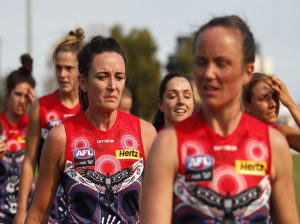
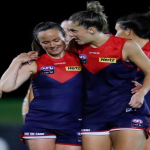
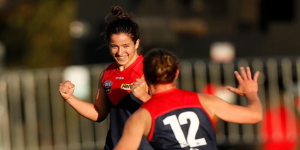
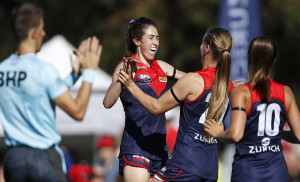
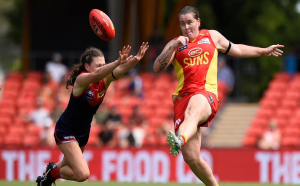
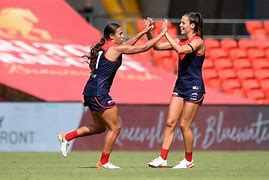

 Follow us on twitter
Follow us on twitter Join our facebook group
Join our facebook group